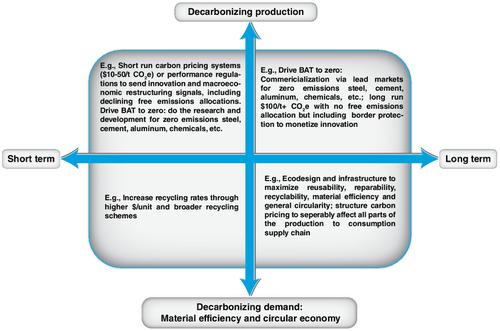当前位置:
X-MOL 学术
›
WIREs Clim. Chang.
›
论文详情
Our official English website, www.x-mol.net, welcomes your feedback! (Note: you will need to create a separate account there.)
Physical and policy pathways to net‐zero emissions industry
WIREs Climate Change ( IF 9.2 ) Pub Date : 2019-12-22 , DOI: 10.1002/wcc.633 Christopher G. F. Bataille 1
WIREs Climate Change ( IF 9.2 ) Pub Date : 2019-12-22 , DOI: 10.1002/wcc.633 Christopher G. F. Bataille 1
Affiliation

|
Several recent studies have identified emerging and near‐commercial process and technological options to transition heavy industry to global net‐zero greenhouse gas (GHG) emissions by mid‐century, as required by the Paris Agreement. To reduce industrial emissions with sufficient speed to meet the Paris goals, this review article argues for the rapid formation of regional and sectoral transition plans, implemented through comprehensive policy packages. These policy packages, which will differ by country, sector, and level of development, must reflect regional capacities, politics, resources, and other key circumstances, and be informed and accepted by the stakeholders who must implement the transition. These packages will likely include a mix of the following mutually reinforcing strategies: reducing and substituting the demand for GHG intense materials (i.e., material efficiency) while raising the quantity and quality of recycling through intentional design and regulation; removal of energy subsidies combined with carbon pricing with competitiveness protection; research and development support for decarbonized production technologies followed by lead markets and subsidized prices during early stage commercialization; sunset policies for older high carbon facilities; electricity, hydrogen and carbon capture, and storage infrastructure planning and support; and finally, supporting institutions, including for a “just workforce & community transition” and monitoring and adjustment of policy effectiveness. Given the paucity of industrial decarbonization perspectives available for in‐transition and less‐developed countries, the review finishes with a discussion of priorities and responsibilities for developed, in‐transition and less developed countries.
中文翻译:

净零排放行业的物理和政策路径
最近的几项研究已经确定了新兴的和接近商业的过程和技术选择,可以按照《巴黎协定》的要求,在本世纪中叶之前将重工业转变为全球净零温室气体(GHG)排放。为了以足够的速度减少工业排放以达到巴黎目标,这篇评论文章主张通过全面的政策方案迅速形成区域和部门过渡计划。这些一揽子政策因国家,部门和发展水平而异,必须反映区域能力,政治,资源和其他关键情况,并且必须由必须实施过渡的利益相关者告知和接受。这些一揽子计划可能会包含以下互为补充的策略:减少并替代对温室气体密集型材料的需求(即材料效率),同时通过有意的设计和法规提高回收的数量和质量;取消能源补贴,结合碳定价和竞争力保护;对脱碳生产技术的研究和开发支持,以及在早期商业化期间的铅市场和补贴价格;旧的高碳设施的日落政策;电力,氢气和碳捕获以及存储基础设施的规划和支持;最后,支持机构,包括建立“公正的劳动力和社区过渡”以及监督和调整政策有效性。鉴于转轨国家和欠发达国家可获得的工业脱碳观点很少,
更新日期:2019-12-22
中文翻译:

净零排放行业的物理和政策路径
最近的几项研究已经确定了新兴的和接近商业的过程和技术选择,可以按照《巴黎协定》的要求,在本世纪中叶之前将重工业转变为全球净零温室气体(GHG)排放。为了以足够的速度减少工业排放以达到巴黎目标,这篇评论文章主张通过全面的政策方案迅速形成区域和部门过渡计划。这些一揽子政策因国家,部门和发展水平而异,必须反映区域能力,政治,资源和其他关键情况,并且必须由必须实施过渡的利益相关者告知和接受。这些一揽子计划可能会包含以下互为补充的策略:减少并替代对温室气体密集型材料的需求(即材料效率),同时通过有意的设计和法规提高回收的数量和质量;取消能源补贴,结合碳定价和竞争力保护;对脱碳生产技术的研究和开发支持,以及在早期商业化期间的铅市场和补贴价格;旧的高碳设施的日落政策;电力,氢气和碳捕获以及存储基础设施的规划和支持;最后,支持机构,包括建立“公正的劳动力和社区过渡”以及监督和调整政策有效性。鉴于转轨国家和欠发达国家可获得的工业脱碳观点很少,



























 京公网安备 11010802027423号
京公网安备 11010802027423号